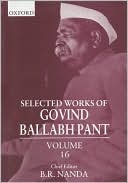

 |

|

The average rating for Selected Works of Govind Ballabh Pant, Vol. 16 based on 2 reviews is 3 stars.
Review # 1 was written on 2018-11-14 00:00:00 Frank Cruz Frank Cruz`WE live in a forest of symbols. There are very few symbols, however, which are imbued with the capacity to energise millions in the pursuit of sublime goals`, asserts Peter Gonsalves in the introduction to Clothing for Liberation. Images, gestures, social behaviour, clothing are all invested with meaning; all are elements of the symbolic order. Gandhi, according to Gonsalves, was an embodiment of rare symbols. Gonsalves brings a new perspective to Gandhian scholarship through Clothing for Liberation. The book is neither a political/historical documentation nor a biographical sketch. It presents Gandhi as a communicator and, more importantly, as an embodiment of the symbols that shaped the course of history. By highlighting Gandhi`s non-verbal communication through a radical choice of clothing, the author endows history with a new political, economic, psychological, social and cultural significance. This book is written with the conviction that Gandhian ideology is and will remain a crucial element of Indian consciousness as a nation. Treating the non-verbal aspect of communication as a text open to interpretation, Gonsalves concentrates on the unique communicative abilities of Gandhi which helped transform him into a symbol of resistance and freedom for Indians. At the time when the freedom movement was at its peak, the rise of large and potentially powerful media institutions and the development of new communication technologies in a society undergoing rapid economic, political and social transformation, paved way for a strategic resistance against the colonial rule. However, Gandhi chose to reach out to the millions of poor who had no access to technology, which he did in a unique manner. The main premise of the book is that Gandhi`s Swadeshi movement was in essence symbolic. While analysing the impact of Gandhian clothing on the masses, Gonsalves raises questions regarding the relationship between communication, democracy, and community. All these themes remain central to the book. In the chapter titled `Gandhi the communicator`, Gonsalves analyses Gandhi in roles such as that of a communicator, a speaker, a journalist and a letter writer. Then he delves on the complex range of Gandhi`s communication devices like silence, fasting, clothing and his mere physical presence which reveal how `Gandhi`s power of communication and strong charisma turned him into the embodiment of Indian independence.` Gonsalves employs the theories of Roland Barthes, Victor Turner and Erving Goffman in the following three chapters to explore the different aspects of Gandhian communication within a social and historical context. Without a working knowledge of semiotics, cultural anthropology and sociology, readers are likely to retain the traditional notions of communication, notions which have been radically changed with the development of communication studies as a separate discipline. Gonsalves admits that the `use of western theories to analyse Gandhian communication may strike as self-contradictory` but sidelines this possibility by declaring his efforts as mutually enriching the western and eastern elements in today`s global dialects. Paradoxically, this illuminates both the strength and weakness of his project. While the application of these western theories on Gandhi`s Swadeshi movement underscores the novelty and value of Gonsalves`s method to future academic research, it also reminds us of the irony that the West still applies western theoretical paradigms to interpret a uniquely dressed, very indigenous, Indian Gandhi. Thus, Gonsalves is quite literally putting Gandhi in a western garb, much like the early nationalists resented by Gandhi who wore Indian pieces of clothing alongside British dress, adhering to the colonial concept of civility. However, in a post-modern epoch where it is no longer possible to speak of originality or uniqueness of the artistic object or any text for that matter, the experience of reading this book is like travelling back to the organic unity of the past via a rich diversity of the theories employed. It provides great insight into the Oriental concept and practice of clothing at that time. Moreover, it is a unique contribution to the post-colonial literature of resistance, promoting a new vision of meaning, and thus of politics, identity and democracy and their interpretation as texts. Gonsalves` take on the subject is a characteristically pleasant style, seemingly engaging the reader in a casual discourse, discussing matters theoretical and factual with an engrossed and attentive reader. The tone of his book is patient and friendly, playfully moderating an academic authority which Gonsalves certainly possesses. Published in Books & Authors |
Review # 2 was written on 2019-03-18 00:00:00 Thomas Riddle Thomas RiddleA very clever writer. I used this book in preparation for the battlefield tour in India. Highly recommended account. |
CAN'T FIND WHAT YOU'RE LOOKING FOR? CLICK HERE!!!